Deck 15: The Nature of the Solar System
Question
Question
Question
Question
Question
Question
Question
Question
Question
Question
Question
Question
Question
Question
Question
Question
Question
Question
Question
Question
Question
Question
Question
Question
Question
Question
Question
Question
Question
Question
Question
Question
Question
Question
Question
Question
Question
Question
Question
Question
Question
Question
Question
Question
Question
Question
Question
Question
Question
Question
Question
Question
Question
Question
Question
Question
Question
Question
Question
Question
Question
Question
Question
Question
Question
Question
Match between columns

Unlock Deck
Sign up to unlock the cards in this deck!
Unlock Deck
Unlock Deck
1/66
Play
Full screen (f)
Deck 15: The Nature of the Solar System
1
The first modern astronomer to propose a Sun-centered universe was ________.
A)Sir Isaac Newton
B)Galileo
C)Tycho Brahe
D)Nicolaus Copernicus
A)Sir Isaac Newton
B)Galileo
C)Tycho Brahe
D)Nicolaus Copernicus
D
2
Why does Venus show fewer impact craters as compared to Mercury or Mars?
A)The planet didn't get as many meteorite impacts as neighboring planets did.
B)The planet was extensively resurfaced by volcanic eruptions after the heavy bombardment period.
C)The thick atmosphere slows down and burns up many incoming meteors.
D)Both B and C are valid reasons, but not A.
A)The planet didn't get as many meteorite impacts as neighboring planets did.
B)The planet was extensively resurfaced by volcanic eruptions after the heavy bombardment period.
C)The thick atmosphere slows down and burns up many incoming meteors.
D)Both B and C are valid reasons, but not A.
D
3
________ gave Galileo a huge advantage over his astronomical predecessors.
A)Use of a telescope
B)Unadulterated genius
C)The fresh perspective of Copernicus's ideas about a geocentric universe
D)Newton's laws of motion
A)Use of a telescope
B)Unadulterated genius
C)The fresh perspective of Copernicus's ideas about a geocentric universe
D)Newton's laws of motion
A
4
On which planet is the Valles Marineris found? How did it form?
A)on Venus, due to volcanic eruptions
B)on Mercury, due to meteorite impacts
C)on Mars, due to down-faulting
D)on Jupiter, due to massive storms
A)on Venus, due to volcanic eruptions
B)on Mercury, due to meteorite impacts
C)on Mars, due to down-faulting
D)on Jupiter, due to massive storms

Unlock Deck
Unlock for access to all 66 flashcards in this deck.
Unlock Deck
k this deck
5
Most of the Moon's craters were produced by ________.
A)the impact of meteoroids
B)volcanic eruptions
C)faulting
D)nuclear testing during the Cold War
A)the impact of meteoroids
B)volcanic eruptions
C)faulting
D)nuclear testing during the Cold War

Unlock Deck
Unlock for access to all 66 flashcards in this deck.
Unlock Deck
k this deck
6

Examine the figure. Which of the lettered locations show the anorthosite-rich lunar highlands?
A)A
B)B
C)both A and B
D)neither A nor B

Unlock Deck
Unlock for access to all 66 flashcards in this deck.
Unlock Deck
k this deck
7
Three laws of planetary motion were discovered by ________.
A)Sir Isaac Newton
B)Johannes Kepler
C)Tycho Brahe
D)Nicolaus Copernicus
A)Sir Isaac Newton
B)Johannes Kepler
C)Tycho Brahe
D)Nicolaus Copernicus

Unlock Deck
Unlock for access to all 66 flashcards in this deck.
Unlock Deck
k this deck
8
Approximately how much further away from the Sun is Neptune, as compared to Earth?
A)3 times as far
B)10 times as far
C)30 times as far
D)310 times as far
A)3 times as far
B)10 times as far
C)30 times as far
D)310 times as far

Unlock Deck
Unlock for access to all 66 flashcards in this deck.
Unlock Deck
k this deck
9
Most of the time, the planets appear to move eastward. However, the occasional apparent westward "drift" of the planets compared to the background stars is called ________.
A)Ptolemaic motion
B)occultation
C)precession
D)retrograde motion
A)Ptolemaic motion
B)occultation
C)precession
D)retrograde motion

Unlock Deck
Unlock for access to all 66 flashcards in this deck.
Unlock Deck
k this deck
10

Compare part "A" of the figure to part "B." Decide whether "A" and "B" represent heliocentric or geocentric solar systems. Which of the following statements best describes the two images?
A)"A" shows a heliocentric solar system; "B" shows a geocentric solar system.
B)"A" shows a geocentric solar system; "B" shows a heliocentric solar system.
C)Both "A" and "B" show a geocentric solar system.
D)Both "A" and "B" show a heliocentric solar system.

Unlock Deck
Unlock for access to all 66 flashcards in this deck.
Unlock Deck
k this deck
11
Vast, circular to elliptical dark-colored smooth areas of the Moon are known as ________.
A)Olympian fields
B)Copernican steppes
C)lunar maria
D)lunar lava flats
A)Olympian fields
B)Copernican steppes
C)lunar maria
D)lunar lava flats

Unlock Deck
Unlock for access to all 66 flashcards in this deck.
Unlock Deck
k this deck
12
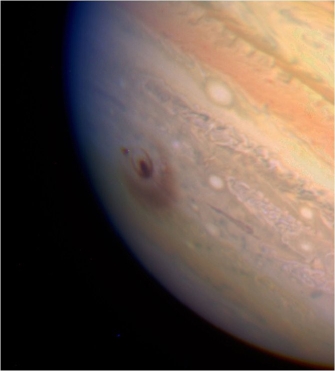
Examine the photo taken in 1994 when Comet Shoemaker-Levy collided with the planet Jupiter. This collision is thought to be similar to the collisions that occurred early in our solar system's history, according to the nebular theory. What happened to the (A)number of objects in the solar system and (B)mass of Jupiter as a result of this collision?
A)(A)It was reduced by one; (B)It increased.
B)(A)It stayed the same; (B)It decreased.
C)(A)It was reduced by one; (B)It stayed the same.
D)(A)It was increased by one; (B)It increased.

Unlock Deck
Unlock for access to all 66 flashcards in this deck.
Unlock Deck
k this deck
13
How did the lunar maria most likely originate?
A)huge impact basins that were nearly filled with basaltic lava flows
B)Huge impact craters filled with frozen carbon dioxide and dark-colored silt and dust.
C)Massive, basaltic comets melted when they hit the lunar surface.
D)The solar wind eroded very wide, shallow basins that filled with lunar dust.
A)huge impact basins that were nearly filled with basaltic lava flows
B)Huge impact craters filled with frozen carbon dioxide and dark-colored silt and dust.
C)Massive, basaltic comets melted when they hit the lunar surface.
D)The solar wind eroded very wide, shallow basins that filled with lunar dust.

Unlock Deck
Unlock for access to all 66 flashcards in this deck.
Unlock Deck
k this deck
14
Which planet has the fastest rate of motion, and the shortest year?
A)Mercury
B)Venus
C)Earth
D)Mars
A)Mercury
B)Venus
C)Earth
D)Mars

Unlock Deck
Unlock for access to all 66 flashcards in this deck.
Unlock Deck
k this deck
15
Which of the following shows the correct order of formation according to the nebular theory?
A)nebula, planetesimals, protoplanets, planets
B)planetesimals, protoplanets, planets, nebula
C)planets, protoplanets, planetesimals, nebula
D)nebula, protoplanets, planetesimals, planets
A)nebula, planetesimals, protoplanets, planets
B)planetesimals, protoplanets, planets, nebula
C)planets, protoplanets, planetesimals, nebula
D)nebula, protoplanets, planetesimals, planets

Unlock Deck
Unlock for access to all 66 flashcards in this deck.
Unlock Deck
k this deck
16
How many astronomical units of distance lie between Earth and the Sun?
A)0)3
B)1)0
C)1)5
D)3)0
A)0)3
B)1)0
C)1)5
D)3)0

Unlock Deck
Unlock for access to all 66 flashcards in this deck.
Unlock Deck
k this deck
17
If gravity were somehow eliminated, Earth would ________.
A)spiral inward toward the Sun
B)spiral outward away from the Sun
C)move in a straight line toward the Sun
D)move in a straight line out into space
A)spiral inward toward the Sun
B)spiral outward away from the Sun
C)move in a straight line toward the Sun
D)move in a straight line out into space

Unlock Deck
Unlock for access to all 66 flashcards in this deck.
Unlock Deck
k this deck
18
________ solar system bodies are more likely to lose their atmospheres.
A)Large, cold
B)Large, warm
C)Small, cold
D)Small, warm
A)Large, cold
B)Large, warm
C)Small, cold
D)Small, warm

Unlock Deck
Unlock for access to all 66 flashcards in this deck.
Unlock Deck
k this deck
19
In the Ptolemaic (Greek)model of the universe, ________.
A)Earth was flat
B)Earth was at the center of the universe
C)the Sun was at the center of the solar system
D)Earth rotated on its axis to produce night and day
A)Earth was flat
B)Earth was at the center of the universe
C)the Sun was at the center of the solar system
D)Earth rotated on its axis to produce night and day

Unlock Deck
Unlock for access to all 66 flashcards in this deck.
Unlock Deck
k this deck
20
The largest known volcano in the solar system is ________.
A)Mauna Loa, Hawaii, on Earth
B)Maat Mons on Venus
C)Solfatara on Jupiter
D)Olympus Mons on Mars
A)Mauna Loa, Hawaii, on Earth
B)Maat Mons on Venus
C)Solfatara on Jupiter
D)Olympus Mons on Mars

Unlock Deck
Unlock for access to all 66 flashcards in this deck.
Unlock Deck
k this deck
21
The nebular theory suggests that, as time goes by, our solar system is trending towards a greater and greater number of smaller and smaller bodies.

Unlock Deck
Unlock for access to all 66 flashcards in this deck.
Unlock Deck
k this deck
22
Lunar regolith contains crystalline rock fragments, glassy fragments, and a moderate amount of organic matter.

Unlock Deck
Unlock for access to all 66 flashcards in this deck.
Unlock Deck
k this deck
23
Eruptive plumes and lava flows rich in sulfur have been photographed on Jupiter's moon, Io.

Unlock Deck
Unlock for access to all 66 flashcards in this deck.
Unlock Deck
k this deck
24
The "celestial sphere" is a feature of the Ptolemaic model of a geocentric universe.

Unlock Deck
Unlock for access to all 66 flashcards in this deck.
Unlock Deck
k this deck
25
Which planet has roving NASA robots on its surface?
A)Mars
B)Mercury
C)Venus
D)Uranus
A)Mars
B)Mercury
C)Venus
D)Uranus

Unlock Deck
Unlock for access to all 66 flashcards in this deck.
Unlock Deck
k this deck
26
Saturn's E ring is thought to be continually replenished by ________.
A)asteroids captured from the Asteroid Belt
B)eruption of water from the moon Enceladus
C)water shed off of passing comets
D)material ejected from Saturn each time it experiences a meteoroid impact
A)asteroids captured from the Asteroid Belt
B)eruption of water from the moon Enceladus
C)water shed off of passing comets
D)material ejected from Saturn each time it experiences a meteoroid impact

Unlock Deck
Unlock for access to all 66 flashcards in this deck.
Unlock Deck
k this deck
27
Meteorites disintegrate and burn up as shooting stars; meteoroids survive an impact event and a trip through Earth's atmosphere.

Unlock Deck
Unlock for access to all 66 flashcards in this deck.
Unlock Deck
k this deck
28
Carbon dioxide is the major gas in the atmosphere of Venus.

Unlock Deck
Unlock for access to all 66 flashcards in this deck.
Unlock Deck
k this deck
29
The planets have circular orbits around the Sun.

Unlock Deck
Unlock for access to all 66 flashcards in this deck.
Unlock Deck
k this deck
30
________ are small, extraterrestrial particles that glow brightly and burn up as they travel through Earth's atmosphere.
A)Meteoroids
B)Moons
C)Meteorites
D)Asteroids
A)Meteoroids
B)Moons
C)Meteorites
D)Asteroids

Unlock Deck
Unlock for access to all 66 flashcards in this deck.
Unlock Deck
k this deck
31
Jupiter is the largest and most massive planet in the solar system.

Unlock Deck
Unlock for access to all 66 flashcards in this deck.
Unlock Deck
k this deck
32
Neptune is the first planet beyond the Asteroid Belt, with Jupiter, Saturn, and Uranus following beyond that, each further away from the Sun.

Unlock Deck
Unlock for access to all 66 flashcards in this deck.
Unlock Deck
k this deck
33
Galileo discovered that the Sun has "blemishes" which we call sunspots.

Unlock Deck
Unlock for access to all 66 flashcards in this deck.
Unlock Deck
k this deck
34
Jupiter is the largest planet. This means it has a large amount of gravity. This gravity is compressing the planet into a smaller and smaller volume, releasing heat that ________.
A)powers immense storms
B)triggers volcanic eruptions
C)imparts retrograde motion
D)produces a mighty ring system
A)powers immense storms
B)triggers volcanic eruptions
C)imparts retrograde motion
D)produces a mighty ring system

Unlock Deck
Unlock for access to all 66 flashcards in this deck.
Unlock Deck
k this deck
35
Which of the following is NOT a dwarf planet?
A)Eris
B)Ceres
C)Pluto
D)Europa
A)Eris
B)Ceres
C)Pluto
D)Europa

Unlock Deck
Unlock for access to all 66 flashcards in this deck.
Unlock Deck
k this deck
36
The Cassini gap refers to the planetless belt of asteroids between Mars and Earth.

Unlock Deck
Unlock for access to all 66 flashcards in this deck.
Unlock Deck
k this deck
37
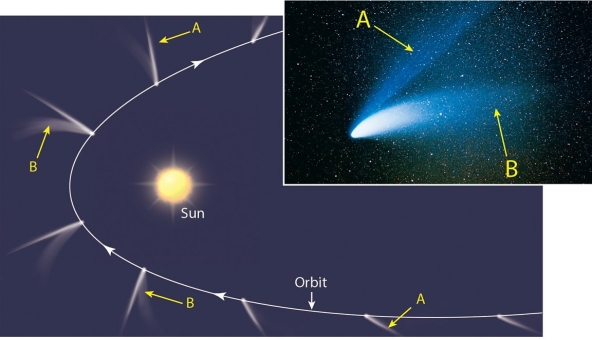
Examine the figure and evaluate the truth of the following statement: The tail labeled "A" is the ion tail of the comet.

Unlock Deck
Unlock for access to all 66 flashcards in this deck.
Unlock Deck
k this deck
38
Of the terrestrial planets, Mercury exhibits the greatest variation in surface temperatures.

Unlock Deck
Unlock for access to all 66 flashcards in this deck.
Unlock Deck
k this deck
39
Epicycles are a feature of the modern conception of a heliocentric solar system.

Unlock Deck
Unlock for access to all 66 flashcards in this deck.
Unlock Deck
k this deck
40
The Martian polar caps are thought to be mainly frozen methane and ammonia.

Unlock Deck
Unlock for access to all 66 flashcards in this deck.
Unlock Deck
k this deck
41
The ________ motion of some of Jupiter's moons indicates that they were likely captured due to the planet's immense gravity.

Unlock Deck
Unlock for access to all 66 flashcards in this deck.
Unlock Deck
k this deck
42
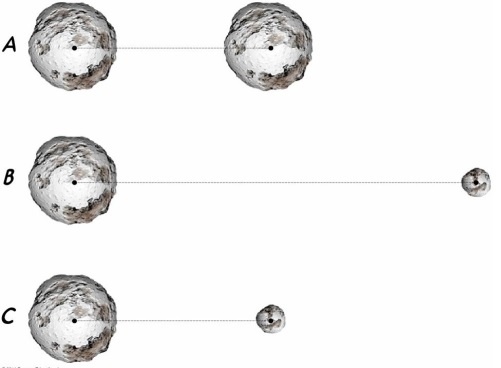
The situation depicted in part A of this figure will have the greatest ________ between the two asteroids.

Unlock Deck
Unlock for access to all 66 flashcards in this deck.
Unlock Deck
k this deck
43
The law of universal gravitation was formulated by ________.

Unlock Deck
Unlock for access to all 66 flashcards in this deck.
Unlock Deck
k this deck
44
________ is the only planet in the solar system whose axis of rotation lies close to the plane of the solar system.

Unlock Deck
Unlock for access to all 66 flashcards in this deck.
Unlock Deck
k this deck
45
________ is the apparent shift in the position of a nearby star when viewed from extreme points in Earth's orbit six months apart.

Unlock Deck
Unlock for access to all 66 flashcards in this deck.
Unlock Deck
k this deck
46
Match the scientist in the second column with their major astronomical discoveries in the first column. Some scientists will have more than one discovery to their name!
A)Nicolaus Copernicus
B)Johannes Kepler
C)Sir Isaac Newton
D)Galileo Galilei
E)Tycho Brahe
1)Planets are circular disks rather than just points of light
2)Stellar parallax should show if Earth shifts position over time.
3)Every body in the universe attracts every other body with a force that is directly proportional to their masses and inversely proportional to the square of the distance between them: the first formulation of the law of universal gravitation.
4)The Sun is at the center of the solar system, and Earth is just another planet.
5)The orbits of the planets are elliptical, and the speed of motion changes when the planets are closer to the Sun (faster)or further away (slower).
6)Jupiter has at least four satellites.
7)Venus exhibits phases just like the Moon does. Furthermore, Venus appears smallest when it is in full phase and thus is farthest from Earth.
8)The Moon's surface is not a smooth glass sphere.
9)The Sun has sunspots; dark regions caused by slightly lower temperatures.
10)The first law of motion is inertia, the natural tendency for a moving object that is unaffected by an outside force is to continue moving at a uniform speed and in a straight line.
A)Nicolaus Copernicus
B)Johannes Kepler
C)Sir Isaac Newton
D)Galileo Galilei
E)Tycho Brahe
1)Planets are circular disks rather than just points of light
2)Stellar parallax should show if Earth shifts position over time.
3)Every body in the universe attracts every other body with a force that is directly proportional to their masses and inversely proportional to the square of the distance between them: the first formulation of the law of universal gravitation.
4)The Sun is at the center of the solar system, and Earth is just another planet.
5)The orbits of the planets are elliptical, and the speed of motion changes when the planets are closer to the Sun (faster)or further away (slower).
6)Jupiter has at least four satellites.
7)Venus exhibits phases just like the Moon does. Furthermore, Venus appears smallest when it is in full phase and thus is farthest from Earth.
8)The Moon's surface is not a smooth glass sphere.
9)The Sun has sunspots; dark regions caused by slightly lower temperatures.
10)The first law of motion is inertia, the natural tendency for a moving object that is unaffected by an outside force is to continue moving at a uniform speed and in a straight line.

Unlock Deck
Unlock for access to all 66 flashcards in this deck.
Unlock Deck
k this deck
47
Identify the small solar system body with its name.
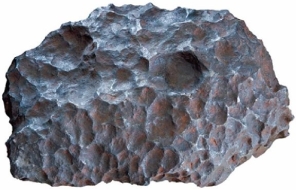


Unlock Deck
Unlock for access to all 66 flashcards in this deck.
Unlock Deck
k this deck
48
Saturn's well-developed rings are made of ________.

Unlock Deck
Unlock for access to all 66 flashcards in this deck.
Unlock Deck
k this deck
49
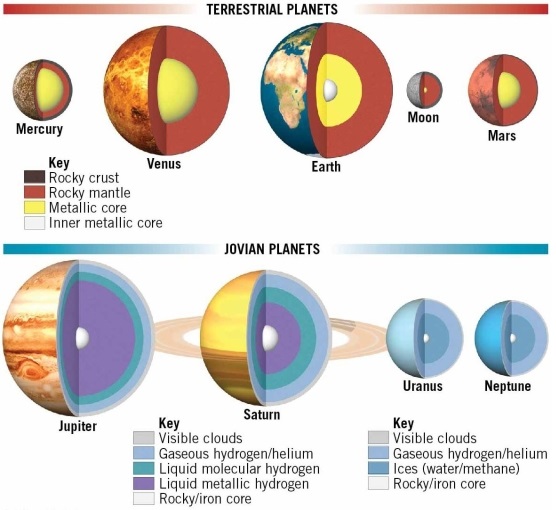
Examine the figure. Explain the origin of the layers inferred to exist within our Solar System's planets. Compare the terrestrial planets to the Jovian planets, and explain the origin of their differences.

Unlock Deck
Unlock for access to all 66 flashcards in this deck.
Unlock Deck
k this deck
50
Identify the small solar system body with its name.
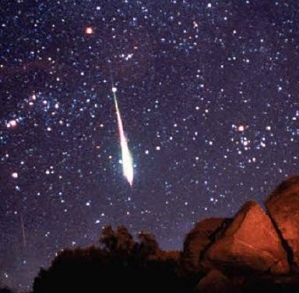


Unlock Deck
Unlock for access to all 66 flashcards in this deck.
Unlock Deck
k this deck
51
Surrounding a comet's nucleus is the broad, glowing area called the ________.

Unlock Deck
Unlock for access to all 66 flashcards in this deck.
Unlock Deck
k this deck
52
Galileo made numerous contributions to the science of astronomy. Discuss two of them in detail.

Unlock Deck
Unlock for access to all 66 flashcards in this deck.
Unlock Deck
k this deck
53
In the Ptolemaic system, planets orbited in small circles called ________ while revolving along large circles called ________.

Unlock Deck
Unlock for access to all 66 flashcards in this deck.
Unlock Deck
k this deck
54
The ________ theory describes how the solar system formed from a huge cloud of gases and small particles produced by an exploding, high-density star.

Unlock Deck
Unlock for access to all 66 flashcards in this deck.
Unlock Deck
k this deck
55
In addition to Earth, the planet ________ shows clear evidence of water erosion.

Unlock Deck
Unlock for access to all 66 flashcards in this deck.
Unlock Deck
k this deck
56
It has been estimated that Halley's Comet, which has an orbital period of 76 years, has a mass of 100 billion tons. Furthermore, it is estimated to lose about 100 million tons of material when its orbit brings it close to the Sun. The maximum remaining life span of Halley's Comet is ________.

Unlock Deck
Unlock for access to all 66 flashcards in this deck.
Unlock Deck
k this deck
57
The Cassini gap is associated with the planet ________.

Unlock Deck
Unlock for access to all 66 flashcards in this deck.
Unlock Deck
k this deck
58
Identify and label each of the solar system features indicated.



Unlock Deck
Unlock for access to all 66 flashcards in this deck.
Unlock Deck
k this deck
59
Identify the small solar system body with its name.
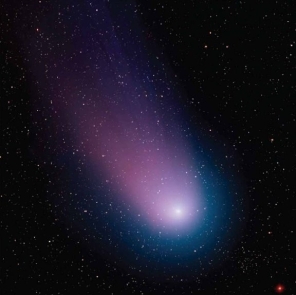


Unlock Deck
Unlock for access to all 66 flashcards in this deck.
Unlock Deck
k this deck
60
Identify the small solar system body with its name.
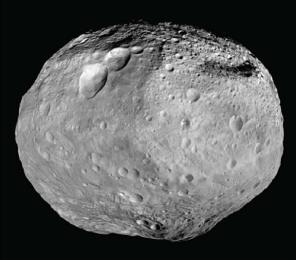


Unlock Deck
Unlock for access to all 66 flashcards in this deck.
Unlock Deck
k this deck
61

Briefly outline the formation of Earth's Moon, referring to the figure where appropriate.

Unlock Deck
Unlock for access to all 66 flashcards in this deck.
Unlock Deck
k this deck
62
Of the other seven planets in our solar system, which is most likely to host Earth-like life? Explain.

Unlock Deck
Unlock for access to all 66 flashcards in this deck.
Unlock Deck
k this deck
63
How is Earth unique as compared to other planets in our solar system? How is it similar? And finally, what geologic information might we obtain by visiting Mars or Venus that would further link Earth to these planets?

Unlock Deck
Unlock for access to all 66 flashcards in this deck.
Unlock Deck
k this deck
64

All else being equal, which of these three asteroid-asteroid situations is most likely to result in a collision? Explain.

Unlock Deck
Unlock for access to all 66 flashcards in this deck.
Unlock Deck
k this deck
65
Why are meteorites a possible source of information regarding the origin and composition of Earth?

Unlock Deck
Unlock for access to all 66 flashcards in this deck.
Unlock Deck
k this deck
67
Match between columns

Unlock Deck
Unlock for access to all 66 flashcards in this deck.
Unlock Deck
k this deck



